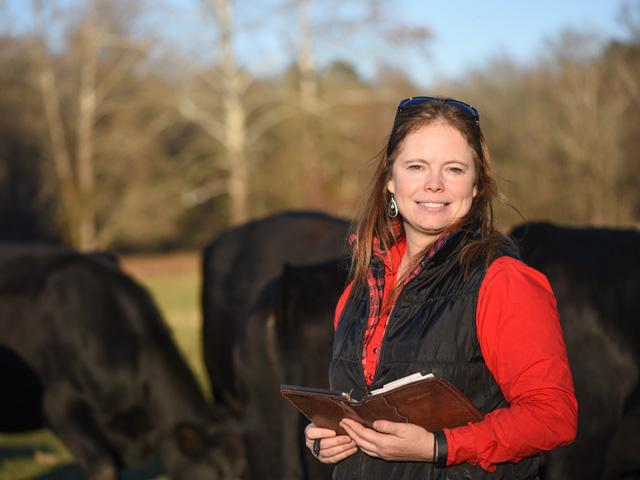Balancing Act
Small-Herd Producers Focus on Working Smarter
More than 90% of U.S. cow herds have fewer than 100 head, with the majority below 50 head. Producers with another job off the farm or multiple farm enterprises know that part-time cattle operators face a unique set of challenges. They also come up with some out-of-the-ordinary ways to make it all work.
Travis Mitchell is a bit of an overachiever with a 160-head cow herd. But he's definitely on the part-time side of the business. A Clemson University Area Livestock and Forages agent, he works 50 to 60 hours a week. He has to be as efficient as possible to make sure his cows are getting the care they need.
"Have a plan," says the Saluda, South Carolina, cattleman. "I never wake up in the morning and wonder what I'm going to be doing. I make lists and try to project what is going to happen. It's important to keep track of those routine tasks that need to be done on the farm before it becomes an emergency situation."
NUTRITION COMES FIRST
First on Mitchell's list is always nutrition. He starts with weekly rotational grazing and stockpiled fescue. The key to making it work is the right fencing setup.
"I utilize cross fencing and temporary electric fence," he says. "My cattle are used to moving pasture to pasture, which makes checking them much more efficient. Rotational grazing forces cows to more evenly graze available forage and gives recently grazed areas a rest period. That allows leaf regrowth and stimulates a deeper and stronger root system."
Most of the year, Mitchell runs cows in one group. However, during his December, January and February breeding season, he runs groups of 35 head to help spread out the bulls. This is also when most of the hay feeding is done. He puts out four to six rolls of hay total per group, spreading it out and sectioning off paddocks so he can give the cows access to a fresh roll, as needed, by moving the poly wire.
P[L1] D[0x0] M[300x250] OOP[F] ADUNIT[] T[]
Mitchell cuts down on hay use thanks to winter annuals drilled into fescue and bermudagrass pastures. The ryegrass starts here in late January and provides great grazing through May. In addition, he stockpiles fescue to provide grazing in late fall and early winter.
When cows are done calving, they go on stockpiled fescue, which helps them to be in excellent body condition come breeding season. Mitchell says they get 80% of their calves in the first 30 days of the season without synchronization or artificial insemination, something he attributes to his focus on nutrition.
"Having a defined calving season is a time-saver for me," he adds, noting he makes sure to have a calving pasture ready and facilities to handle dystocia. He also sets aside time to tag and castrate bull calves.
FOCUS ON DOCILITY
Peyton Sapp, a county Extension coordinator in Burke County, Georgia, and his wife, Pam, a county Extension coordinator in neighboring Jefferson County, place an emphasis on docility in their part-time livestock business.
Pam says their 30-cow herd needs the right temperament because they are hands-on producers. "And you can't band a calf properly if the mama is chasing you," Peyton adds.
Pam says they also utilize expected progeny differences (EPDs) for calving ease to make the herd easier to manage; and if they do have to pull a calf, that cow is usually moved out of the herd pretty quickly. For those unavoidable times, though, they are ready with a calving kit by the back door, complete with OB Lube, chains, a ratchet, a tube of K-Mag, iodine for navels, ear tags and bands for the bull calves.
To cut down on hay feeding, these producers plant winter grazing, but they don't try to put up hay themselves. What they buy they test to make sure it is the right quality and won't leave them in need of a supplement. They also soil-test to ensure pastures are productive to further limit hay purchases.
BARTERING FOR LABOR
Lucy Ray, county Extension director in Morgan County, Georgia, says she is all about bartering to hold down costs as a small livestock producer.
Ray says she has three college students who pasture-board horses at her farm. In exchange for a reduced board fee, they help feed her freezer steers and fix fences.
"We have a schedule of who is going to feed what," Ray explains. "The only problem is they keep naming the calves, and that doesn't work too well when I take them to the processor and bring back the meat."
She also allows some hunting on the property, noting she doesn't charge the hunters in exchange for helping with fence repair and mowing pastures.
A local dairyman helps by cutting her hay on halves. He stores his equipment at her farm, and in return, he puts out hay for her.
Ray says making it all work takes some thought -- and patience. One of the keys to being a successful part-time cattle producer comes down to how good you are at planning ahead.
A tighter breeding season or boosting the nutritional aspect of the operation will make the work easier, not harder. Ask anyone who's been there, and they'll probably tell you part-time cattle production can be a great income stream; it just takes a little planning.
(c) Copyright 2022 DTN, LLC. All rights reserved.






